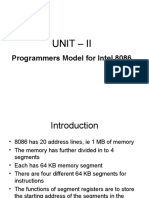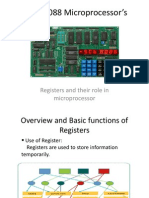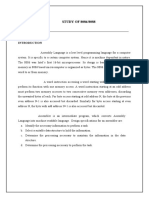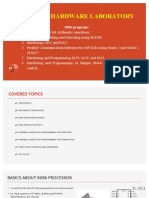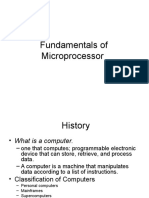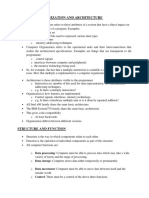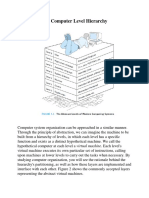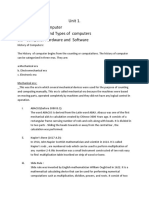Chapter 12
Processor Structure and Function
Central Processing Unit
CPU architecture, Register organization, Instruction formats and addressing
modes(Intel processor).,Basic instruction cycle. Control unit Operation ,Micro
3.1 operations : Fetch, Indirect, Interrupt , Execute cycle Control of the processor,
Functioning of micro programmed control unit, Micro instruction Execution and
Sequencing, Applications of Micro programming
RISC v/s CISC processors, RISC and CISC Architecture, RISC pipelining, Case
3.2
study on SPARC
CPU Structure
• CPU must:
– Fetch instructions
– Interpret instructions
– Fetch data
– Process data
– Write data
CPU With Systems Bus
CPU Internal Structure
Registers
• CPU must have some working space
(temporary storage)
• Called registers
• Number and function vary between processor
designs
• One of the major design decisions
• Top level of memory hierarchy
User Visible Registers
• General Purpose
• Data
• Address
• Condition Codes
Example Register Organizations
General Purpose Registers
• May be true general purpose
• May be restricted
• May be used for data or addressing
• Data
– Accumulator
• Addressing
– Segment
• Why make them general purpose?
– Increase flexibility and programmer options
– Increase instruction size & complexity
How big?
• Large enough to hold full address
• Large enough to hold full word
• Often possible to combine two data registers
– C programming
– double int a;
– long int a;
Condition Code Registers(Flag Reg)
• Sets of individual bits
– e.g. result of last operation was zero
• Can be read (implicitly) by programs
– e.g. Jump if zero
• Can not (usually) be set by programs
Control & Status Registers
• Program Counter (PC)
• Instruction Decoding Register(IR)
• Memory Address Register(MAR)
• Memory Buffer Register(MBR)
Registers
• Memory Address Register (MAR)
– Connected to address bus
– Specifies address for read or write op
• Memory Buffer Register (MBR)
– Connected to data bus
– Holds data to write or last data read
• Program Counter (PC)
– Holds address of next instruction to be fetched
• Instruction Register (IR)
– Holds last instruction fetched/current instruction being
executed
Program Status Word
• A set of bits
• Includes Condition Codes
• Sign of last result
• Zero
• Carry
• Equal
• Overflow
• Interrupt enable/disable
• Supervisor
General Registers
AX is the primary accumulator; it is used in input/output and most
arithmetic instructions. For example, in multiplication operation, one operand
is stored in EAX or AX or AL register according to the size of the operand.
BX is known as the base register, as it could be used in indexed addressing.
CX is known as the count register, as the ECX, CX registers store the loop
count in iterative operations.
DX is known as the data register. It is also used in input/output operations.
It is also used with AX register along with DX for multiply and divide
operations involving large values.
Pointer Registers
• Instruction Pointer (IP) − The 16-bit IP register stores the offset address of the
next instruction to be executed. IP in association with the CS register (as CS:IP)
gives the complete address of the current instruction in the code segment.
• Stack Pointer (SP) − The 16-bit SP register provides the offset value within the
program stack. SP in association with the SS register (SS:SP) refers to be current
position of data or address within the program stack.
• Base Pointer (BP) − The 16-bit BP register mainly helps in referencing the
parameter variables passed to a subroutine. The address in SS register is combined
with the offset in BP to get the location of the parameter. BP can also be combined
with DI and SI as base register for special addressing.
Index Registers
SI and DI, are used for indexed addressing and sometimes used in
addition and subtraction.
There are two sets of index pointers −
Source Index (SI) − It is used as source index for string operations.
Destination Index (DI) − It is used as destination index for string
operations.
Control Registers
• The 32-bit instruction pointer register and the 32-bit flags register
combined are considered as the control registers.
• Many instructions involve comparisons and mathematical
calculations and change the status of the flags and some other
conditional instructions test the value of these status flags to take
the control flow to other location.
• The common flag bits are:
FLAG REGISTER 8086
• Overflow Flag (OF) − It indicates the overflow of a high-order bit
(leftmost bit) of data after a signed arithmetic operation.
• Direction Flag (DF) − It determines left or right direction for
moving or comparing string data. When the DF value is 0, the
string operation takes left-to-right direction and when the value is
set to 1, the string operation takes right-to-left direction.
• Trap Flag (TF) − It allows setting the operation of the processor in single-step mode.
The DEBUG program we used sets the trap flag, so we could step through the
execution one instruction at a time.
• Sign Flag (SF) − It shows the sign of the result of an arithmetic operation. This flag
is set according to the sign of a data item following the arithmetic operation. The
sign is indicated by the high-order of leftmost bit. A positive result clears the value
of SF to 0 and negative result sets it to 1.
• Zero Flag (ZF) − It indicates the result of an arithmetic or comparison operation. A
nonzero result clears the zero flag to 0, and a zero result sets it to 1.
• Interrupt Flag (IF) − It determines whether the external
interrupts like keyboard entry, etc., are to be ignored or
processed. It disables the external interrupt when the value is
0 and enables interrupts when set to 1.
• Auxiliary Carry Flag (AF) − It contains the carry from bit 3 to bit 4 following an
arithmetic operation; used for specialized arithmetic. The AF is set when a 1-
byte arithmetic operation causes a carry from bit 3 into bit 4.
• Parity Flag (PF) − It indicates the total number of 1-bits in the result obtained
from an arithmetic operation. An even number of 1-bits clears the parity flag
to 0 and an odd number of 1-bits sets the parity flag to 1.
• Carry Flag (CF) − It contains the carry of 0 or 1 from a high-order bit (leftmost)
after an arithmetic operation. It also stores the contents of last bit of
a shift or rotate operation.
Segment Registers
• Segments are specific areas defined in a program for containing data, code and
stack. There are three main segments −
• Code Segment − It contains all the instructions to be executed. A 16-bit Code
Segment register or CS register stores the starting address of the code segment.
• Data Segment(DS,ES) − It contains data, constants and work areas. A 16-bit Data
Segment register or DS register stores the starting address of the data segment.
• Stack Segment − It contains data and return addresses of procedures or
subroutines. It is implemented as a 'stack' data structure. The Stack Segment
register or SS register stores the starting address of the stack.
INSTRUCTION FORMAT
(PENTIUM)
• Instruction :- MOV A (Destination),B(Source)
• Examples:
MOV AX,BX
Add AX,4
JMP
MUL 3,5
• Opcodes-Operation Code
• Operands-Data
Instruction=Opcodes+Operands.
Instruction Formats
• Layout of bits in an instruction
• Includes opcode
• Includes (implicit or explicit) operand(s)
• Usually more than one instruction format in
an instruction set
Instruction Length
• Affected by and affects:
– Memory size
– Memory organization
– Bus structure
– CPU complexity
– CPU speed
User wants more opcodes, operands, addressing
modes , address range
Allocation of Bits
• Number of addressing modes
• Number of operands
• Register versus memory
• Number of register sets
• Address range
• Address Granularity
Pentium Instruction Format
PENTIUM INSTRUCTION FORMAT
• Instruction Prefixes-LOCK prefix or one of the REPEAT
prefixes(REPE,REPNE,REPZ,REPNZ….)
• Segment Override-explicitly specifying segment register
• Address Size-16 or 32 bit (switch)
• Operand Size-16 or 32 bit (switch)
PENTIUM INSTRUCTION FORMAT
• Opcode
• Mod R/m-addressing
– Mod+ r/m (combined info of registers and addressing
modes)
– Register-register or opcode info
• SIB
– Scale-scale factor for scaled indexing
– Index-specifies index register(SI,DI)
– Base-specifies base register(BX)
• Displacement-8 or 16 or 32 bit
• Immediate-provides the value of 8/16/32 bit
operand
PENTIUM INSTRUCTION FORMAT
• Instruction Prefixes-LOCK prefix or one of the REPEAT
prefixes
• Segment Override-explicitly specifying segment register
• Address Size-16 or 32 bit (switch)
• Operand Size-16 or 32 bit (switch)
William Stallings
Computer Organization
and Architecture
6th Edition
Chapter 11
Instruction Sets:
Addressing Modes and Formats
Addressing Modes
• Immediate
• Direct
• Indirect
• Register
• Register Indirect
• Displacement (Indexed)
• Stack
35
Immediate Addressing
• In this mode data is present in address field of
instruction .
• Designed like one address instruction format
– Note:Limitation in the immediate mode is that the
range of constants are restricted by size of address
field.
• FEATURES
– Operand is part of instruction
– Operand = address field
– No memory reference to fetch data
– Fast
– Limited range
36
MOV AX, 2000
MOV CL, 0A
ADD AL, 45
ADD AX, 0000
MOV CX, 4929 H
ADD AX, 2387 H,
MOV AL, FFH 37
Direct(M) Addressing
Diagram
38
MOV AX, [DISP]
MOV AX, [0500]
ADD AL,[0301]
39
• The operand’s offset is given in the instruction as an 8 bit or
16 bit displacement element.
• In this addressing mode the 16 bit effective address of the
data is the part of the instruction.
• Here only one memory reference operation is required to
access the data.
40
Direct Addressing
• Address field contains address of operand
• EFFECTIVE ADDRESS EA = address field (A)
– Look in memory at address value for operand
• Single memory reference to access data
• No additional calculations to work out effective
address
• Limited address space
41
Indirect Addressing Diagram
42
• In this mode address field of instruction contains the address
of effective address.
• Here two references are required.
1st reference to get effective address.
2nd reference to access the data.
.
43
Based on the availability of Effective address, Indirect mode is of two kind:
• REGISTER INDIRECT: In this mode effective
address is in the register, and corresponding
register name will be maintained in the
address field of an instruction.
– Here one register reference,one memory reference is required to access
44
the data.
• MEMORY INDIRECT: In this mode effective
address is in the memory, and corresponding
memory address will be maintained in the
address field of an instruction.
– Here two memory reference is required to access the data
45
Indirect Addressing (1/2)
• Memory cell pointed to by address field contains the address
of (pointer to) the operand
• EA =(A)
– Look in A, find address (A) and look there for operand
• e.g. ADD AX, (A)
– Add contents of cell pointed to by contents of A to accumulator
46
Indirect Addressing (2/2)
• Large address space
• 2n where n = word length
• May be nested, multilevel, cascaded
– e.g. EA = (((A)))
• Draw the diagram yourself
• Multiple memory accesses to find operand
• Hence slower
47
Register Addressing Diagram
48
• In register addressing the operand is placed in one of 8 bit or
16 bit general purpose registers.
• The data is in the register that is specified by the instruction.
– Here one register reference is required to access the data.
49
Register Addressing (1/2)
• Operand is held in register named in address filed
• EA = R
• Limited number of registers
• Very small address field needed
– Shorter instructions
– Faster instruction fetch
– MOV AX, BX
– ADD AX, BX
50
Register Addressing (2/2)
• No memory access
• Very fast execution
• Very limited address space
• Multiple registers helps performance
– Requires good assembly programming or compiler writing
– N.B. C programming
• register int a;
• c.f. Direct addressing
51
Register Indirect Addressing Diagram
52
• In this addressing the operand’s offset is placed in any one of
the registers BX,BP,SI,DI as specified in the instruction.
• The effective address of the data is in the base register or an
index register that is specified by the instruction.
– Here two register reference is required to access the data.
53
Register Indirect Addressing
MOV AX, [BX]
(move the contents of memory location s addressed by the register BX to the register
AX)
MOV AX, [DI]
ADD AL, [BX]
MOV AX, [SI]
• Operand is in memory cell pointed to by contents of register R
• Large address space (2n)
• One fewer memory access than indirect addressing
54
Displacement Addressing
Diagram
55
Displacement Addressing
• EA = A + (R)
• Effective address=start address + displacement
• Effective address=Offset + (Segment Register)
• Use direct and register indirect
• Address field hold two values
– A = base value
– R = register that holds displacement
56
– or vice versa
Base-Register Addressing
• Base register addressing mode is used to implement inter
segment transfer of control.
• In this mode effective address is obtained by adding base
register value to address field value.
• EA= Base register + Address field value.
• PC= Base register + Relative value.
57
Indexed Addressing
The operand’s offset is the sum of the content of an
index register SI or DI and an 8 bit or 16 bit
displacement.
• MOV AX, [SI +05]
58
Stack Addressing
• Operand is (implicitly) on top of stack
• e.g.
– ADD Pop top two items from stack and add and push
59
Instruction Cycle
Instruction Cycle
• Two steps:
– Fetch
– Execute
Instruction Cycle with Interrupts
Instruction Cycle
• It is the time in which a single instruction is fetched
from memory, decoded, and executed
• An Instruction Cycle requires the following subcycle:
– FETCH
– EXECUTE
– INDIRECT
– INTERRUPT
Instruction Cycle
Fetch
Read next instruction from memory into the processor
Indirect Cycle (Decode Cycle)
May require memory access to fetch operands, therefore more
memory accesses.
Interrupt
Save current instruction and service the interrupt
Execute
Interpret the opcode and perform the indicated operation
Instruction Cycle
Fetch
Interrupt Indirect
Indirect
Execute
Instruction Cycle State Diagram
Instruction Cycle State Diagram
• This illustrates more correctly the nature of the instruction cycle.
• Once an instruction is fetched, its operand specifiers must be
identified.
• Each input operand in memory is then fetched, and this process
may require indirect addressing.
• Register-based operands need not be fetched.
• Once the opcode is executed, a similar process may be needed to
store the result in main memory.
Registers
• Memory Address Register (MAR)
– Connected to address bus
– Specifies address for read or write op
• Memory Buffer Register (MBR)
– Connected to data bus
– Holds data to write or last data read
• Program Counter (PC)
– Holds address of next instruction to be fetched
• Instruction Register (IR)
– Holds last instruction fetched/current instruction being executed
Fetch Cycle
• Program Counter (PC) holds address of next instruction to be
fetched
• Processor fetches instruction from memory location pointed to by
PC
• Increment PC
– Unless told otherwise
• Instruction loaded into Instruction Register (IR)
• Processor interprets instruction and performs required actions
Fetch Sequence (symbolic)
• The Fetch Cycle –
At the beginning of the fetch cycle, the address
of the next instruction to be executed is in
the Program Counter(PC).
Step 1:
• The address in the program counter is moved to the
memory address register(MAR), as this is the only
register which is connected to address lines of the
system bus.
Step 2:
• The address in MAR is placed on the address bus, now the
control unit issues a READ command on the control bus, and the
result appears on the data bus and is then copied into the
memory buffer register(MBR).
• Program counter is incremented by one, to get ready for the
next instruction.(These two action can be performed
simultaneously to save time)
Step 3:
• The content of the MBR is moved to the
instruction register(IR)
THIRD STEP
Indirect Cycle
Step 1:
The address field of the instruction is transferred to the MAR.
This is used to fetch the address of the operand.
Step 2:
The address field of the IR is updated from the MBR.(So that it now
contains a direct addressing rather than indirect addressing)
Step 3:
The IR is now in the state, as if indirect addressing has not been
occurred.
Interrupt Cycle
• At the completion of the Execute Cycle, a test is made to
determine whether any enabled interrupt has occurred or
not.
• If an enabled interrupt has occurred then Interrupt Cycle
occurs.
• The nature of this cycle varies greatly from one machine to
another.
• Step 1: Contents of the PC is transferred to the MBR, so that they
can be saved for return.
Step 2: MAR is loaded with the address at which the contents of
the PC are to be saved.
PC is loaded with the address of the start of the interrupt-
processing routine.
Step 3: MBR, containing the old value of PC, is stored in memory.
– Note: In step 2, two actions are implemented as one micro-operation. However,
most processor provide multiple types of interrupts, it may take one or more micro-
operation to obtain the save_address and the routine_address before they are
transferred to the MAR and PC respectively.a
Execute Cycle (ADD)
Different for each instruction
e.g. ADD R1,X - add the contents of location X to
Register 1 , result in R1
t1 : IR MAR
t 2 : MEMORY MDR
t 3 : MDR R1 R1
Constituent Elements of
Program Execution
Micro-Operations
• A computer executes a program
• Fetch/execute cycle
• Each cycle has a number of steps
• Called micro-operations
• Each step does very little
• Atomic operation of CPU
Types of Micro-operation
• Transfer data between registers
• Transfer data from register to external
• Transfer data from external to register
• Perform arithmetic or logical ops
William Stallings
Computer Organization
and Architecture
8th Edition
Chapter 15
Control Unit Operation
Functional Requirements(of Control
Unit)
Define basic elements of processor
Describe micro-operations processor performs
Determine functions control unit must
perform
Registers
Memory Address Register (MAR)
◦ Connected to address bus
◦ Specifies address for read or write op
Memory Buffer Register (MBR)
◦ Connected to data bus
◦ Holds data to write or last data read
Program Counter (PC)
◦ Holds address of next instruction to be fetched
Instruction Register (IR)
◦ Holds last instruction fetched/current instruction
being executed
Model of Control Unit
Functions of Control Unit
Sequencing
◦ Causing the CPU to step through a series of micro-operations
Execution
◦ Causing the performance of each micro-op
This is done using Control Signals
Control Signals( input )
Clock
◦ One micro-instruction (or set of parallel micro-
instructions) per clock cycle
Instruction register
◦ Op-code for current instruction
◦ Determines which micro-instructions are
performed
Flags
◦ State of CPU
◦ Results of previous operations
From control bus
◦ Interrupts
◦ Acknowledgements
Control Signals - output
Within CPU
◦ Cause data movement
◦ Activate specific functions
Via control bus
◦ To memory
◦ To I/O modules
Control Unit Organization
Implementation
• All the control unit does is generate a set of control signals
• Each control signal is on or off
• Represent each control signal by a bit
• Have a control word for each micro-operation
• Have a sequence of control words for each machine code instruction
• Add an address to specify the next micro-instruction, depending on
conditions
Chapter 16
Micro-programmed Control
William Stallings
Computer Organization
and Architecture
8th Edition
Functioning of Micro programmed
Control Unit
Micro programmed Control Unit Func
Sequence logic unit issues read command
Word specified in control address register is read into control
buffer register
Control buffer register contents generates control signals and next
address information
Sequence logic loads new address into control buffer register
based on next address information from control buffer register
and ALU flags
Next Address Decision
• Depending on ALU flags and control buffer
register
– Get next instruction
• Add 1 to control address register
– Jump to new routine based on jump
microinstruction
• Load address field of control buffer register into control
address register
– Jump to machine instruction routine
• Load control address register based on opcode in IR
Advantages and Disadvantages of
Microprogramming
• Simplifies design of control unit
– Cheaper
– Less error-prone
• Slower
Tasks Done By Microprogrammed
Control Unit
• Microinstruction sequencing
• Microinstruction execution
• Must consider both together
Micro-instruction Types
Each micro-instruction specifies many different
micro-operations to be performed in parallel
◦ (horizontal micro-programming)
Each micro-instruction specifies single (or few)
micro-operations to be performed
◦ (vertical micro-programming)
Typical Microinstruction Formats
Vertical Micro-programming
• Width is narrow
• Limited ability to express parallelism
• Considerable encoding of control information requires
external memory word decoder to identify the exact
control line being manipulated
Horizontal Micro-programming
• Wide memory word
• High degree of parallel operations possible
• Little encoding of control information
William Stallings
Computer Organization
and Architecture
Chapter 13
7th Edition
Reduced Instruction Set Computers
v/s
Complex Instruction Set Computers
Introduction
• The architectural design of the CPU is RISC & CISC.
• Hardware fused with software (Intel v/s Apple)
• Intel’s hardware oriented approach is termed as CISC while that of Apple is
RISC
• Instruction Set Architecture- Interface to allow easy communication between
the programmer and the hardware.
• ISA- execution of data, copying data, deleting it, editing
• Instruction Set , Addressing Modes,
RISC-Reduced Instruction Set
Computer
• RISC processor design has separate digital circuitry in
the control unit
• Signals needed for the execution of each instruction in
the instruction set of the processor.
• Examples of RISC processors:
– IBM RS6000, MC88100
– DEC’s Alpha 21064, 21164 and 21264 processors
CISC-Complex Instruction Set
Computer
• Control unit micro-electronic circuitry
- generates a set of control signals activated by a
micro-code
• The primary goal of CISC architecture is to complete a
task in as few lines of assembly code as possible.
• Examples of CISC processors are:
– Intel 386, 486, Pentium, Pentium Pro, Pentium II, Pentium III
– Motorola’s 68000, 68020, 68040, etc.
CISC processor features
• Instruction set with 120-350 instructions
• Variable instruction/data formats
• Small set of general purpose registers(8-24)
• A large number of addressing modes
• High dependency on micro program
• Complex instructions to support HLL features
CISC processor features
• Complex pipelining
• Many functional chips needed to design a computer
using CISC
• Difficult to design a superscalar processor
RISC processor features
• Instruction set with limited number of instructions
• Simple instruction format
• Large set of CPU registers
• Very few addressing modes
• Easy to construct a superscalar processor
RISC processor features
• Hardwired control unit for sequencing
microinstructions
• Supports on chip cache memory
• All functional units on a single chip
• Simple pipelining
PIPELINING-Ex Laundry Analogy
Problems with pipeline
• Stalling of pipeline
– Data Dependency
– Branch,etc…
RISC Pipelining
• Most instructions are register to register
• Two phases of execution, I E
– I: Instruction fetch
– E: Execute
• ALU operation with register input and output
• For load and store(memory),I E D
– I: Instruction fetch
– E: Execute
• Calculate memory address
– D: Memory
• Register to memory or memory to register operation
NOP is typically used to generate a delay in
execution or to reserve space in code memory.
RISC Architecture
• 9 functional units interconnected by multiple data paths with width
ranging from 32-128 bits
• All internal- external buses are 32 bit wide
• Separate instruction (4KB)and data cache(8KB)
• MMU- implements paged virtual memory structure
• RISC integer unit executes load,store,fetch etc
• 2 floating point units , multiplier unit and adder unit
• Graphics unit to support 3D drawing
CISC Architecture

